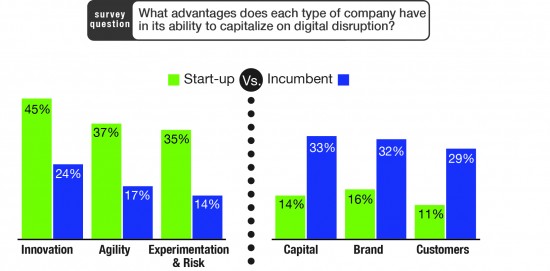As we explored in my previous blog, today’s rampant pace of innovation can be likened to a Digital Vortex, where ideas, technologies, and even entire industries are swept to the center of the Vortex — recombining and merging into disruptive new business models.
In such an environment, digital business transformation is critical — and demands decisive top-down leadership. Nevertheless, as our Digital Vortex research revealed, 45 percent of companies don’t consider digital disruption a board-level concern.
That represents a dangerous level of complacency, especially for market incumbents. We all know the names of seemingly immune incumbents that rested easy as innovative disruptors combined technologies into new business models — challenging and disrupting them from seemingly out of nowhere. Those disruptors were innovative, agile, and, of course, digital (see chart below from our Digital Vortex research).

As Chris Skinner, author of Digital Bank, told our team, “If banks aren’t digital, they’re going to be dead in the water.” Chris was interviewed for our white paper on digital transformation in banking, but the concept holds true in all industries. Whether manufacturing, retail, public sector, healthcare, media, or any other industry, digital transformation is no longer a luxury; it is a necessity.
This begs the question, how do executive leaders of market incumbents — who may be encumbered by the very strategies and processes that led to their initial success — begin to lead the charge to the center of the Digital Vortex?
In my last blog, we discussed five key questions that business leaders should ask as they assess their current state of digital readiness and maturity. Beyond that initial assessment, they will need to guide their organizations carefully.
I believe success will require focus on these five key areas, which illustrate how a true digital business can function:
- Lead from the Top Down: Given the magnitude of digital transformation, only top-down leadership will ensure that new strategic directions are cultivated throughout the organization and the right culture of innovation is created.
- Create the Workforce of the Future: Digital business transformation requires a next-generation workforce that is digitally savvy, creative, and accustomed to constant change. Collaboration solutions and the sharing of information — in real time and across fragmented silos — are critical.
- Merge Business Processes and Technology: By knocking down silos and integrating IT and operational technology (OT), organizations can drive real-time agility and deliver new levels of business and operational efficiency as they connect everything, embrace analytics, and secure their technology and operations.
- Ideate and Innovate Fast: Agile IT, automated business processes, enhanced collaboration and decision-making, real-time insight — all of these factors combine to create fast innovation. The digital business ideates quickly as creative, connected employees drive rapid prototypes and speed time to market — and respond to ever-changing opportunities, successes, and failures.
- Cultivate the Partner Ecosystem: Organizations will need to rethink their partner ecosystems as they seek unique value that will create new disruption. Cultivating the right network of vendors, partners, and contract workers will be critical to smoother and more impactful digital business transformation.
As I see it, these steps toward digital transformation will arm incumbents with the ability to combine technologies in unexpected ways at the center of the Digital Vortex. Once that happens, incumbents can be the agile disruptors that no one sees coming.
Not so long ago in advent of cloud computing it looked like internal IT can and should be outsourced. But from what is evolving today around digitization it looks like those with strong internal IT knowledge can be the ones leading the way.
Great to see the reference to the importance of building new partner ecosystem as a primary driver of successful digital transformations
Our research is proving that not only are digital-driven partnerships essential but that they are re-shaping traditional partnerships engagement models and traditional partnering roles
We welcome a dialog on our site to explore the implications and mandates of the C-Suite to re-think partnerships in the digital age
I would add ‘Lean innovation process’ to (4.). smaller heterogenic teams are often not only agile, but also far more effective.